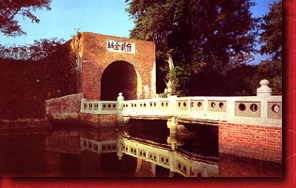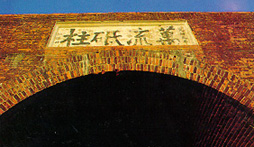


[ Construction Date] 1875
This fort (commonly known as the Great Fort)was constructed under the direction of Shen Pao-chen at Nan-wen in the district of An-p'ing, the area formerly known as Erh-k'un-shen. The fort was erected in connection with the Moutan-she Tribal Incident of 1871. In that year a group of fishermen from the Ryukyu Islands were driven to Taiwan by a storm at sea; they came ashore at Heng-ch'un, a place on the southernmost tip of the island. There they were slaughtered by aborigines.(Moutan-she was a place where these tribesmen dwelt.) The Japanese government, which sought to place the Ryukyu Islands under its suzerainty (the territory then being a Chinese protectorate), took advantage of the incident as an excuse to invade Taiwan in May 1874. Shen Pao-chen(1820-1879), a native of Fukien and one of the 'Four Great Ministers of the Era of Reform' of the late Ch'ing, was sent by the Ch'ing government to Taiwan to negotiate with the invaders. As it happened, however, the incident was resolved through the secret mediation of J.F.Wade, British consul at Peking; the Ch'ing government agreed to pay the Japanese an indemnity of 500,000 taels of gold, and in addition had to renounce all claim by China to her jurisdiction over the Ryukyus. However, the incident had revealed the strategic weakness of Taiwan's defenses, and this Shen set out to remedy. He was one of those who believed that the source of China's future strength must lie in the progressive build-up of her naval armaments and sea defenses; the Erh-k'un-shen Fort was meant to serve as an important step toward such a defense network for Taiwan. A French construction expert was invited to design and direct the construction work, and building materials, including Western-style bricks, were taken from nearby Fort Zeelandia(built by the Dutch in the 1620's). Work began in 1874-the project was initiated by Shen immediately upon his arrival-and was completed the following year. Caligraphy for the inscription engraved in the arch over the gate, 'The Golden Bastion of a Hundred Million Years,' and for the inscription over the inner gate, 'Indomitable Point in the Universal Ebb and Flow, came from the writing brush of Shen himself.
Subsequently, the fort's defenses were continuously enlarged, intil in 1894 its array of armaments inculuded five muzzle-loading 18-ton cannons, and four smaller 20-pound breech-loading cannons in emplacement. The firepower of this arsenal was brought into play during the short-lived resistance to Japanese takeover in the summer of 1895.
During their administration of the island, the Japanese bulilt a bridge over the moat; at the time of the First World War the old artillery was sold off in exchange for modern arms, until hardly a single piece was left. Later, the expansion of Tainan City resulted in the commercial development of the land around the fort, so that its military usefulness further declined and eventually disappeared altogether.
The entrance to the fort is a brick-faced arch in a protrudent gate. The arch is the largest and deepest of its kind built in Taiwan during the Ch'ing period. The work was constructed entirely with red brick. Characters engraved above the gate are calligraphy by its founder Shen Pao-chen.

Inscription above the inner gate(also visible in the photo at lower right) is calligraphy from the brush of Shen Pao-chen. This view also reveals the three-layer brick construction of the arch which lends both strength and grace to the structure.
![]()